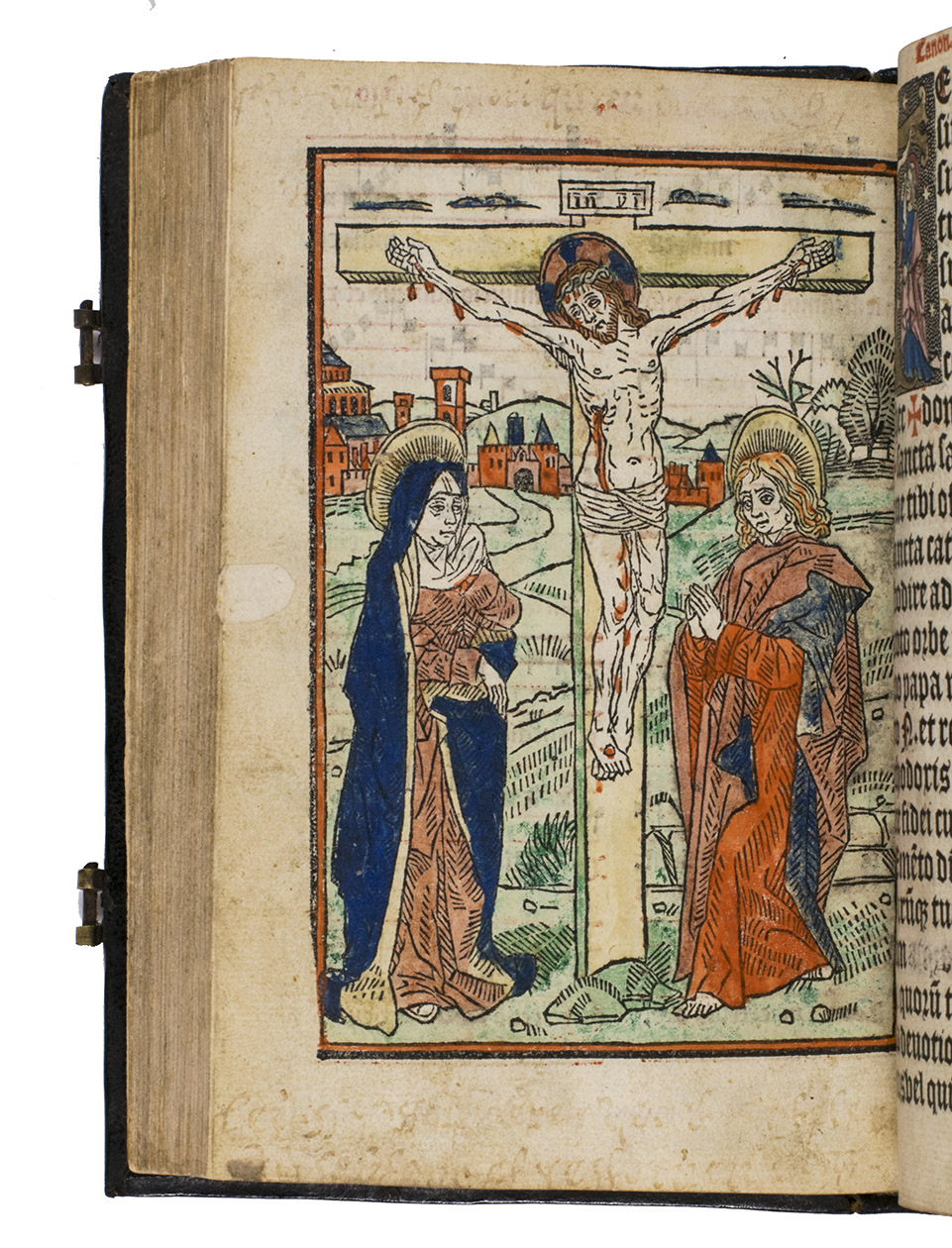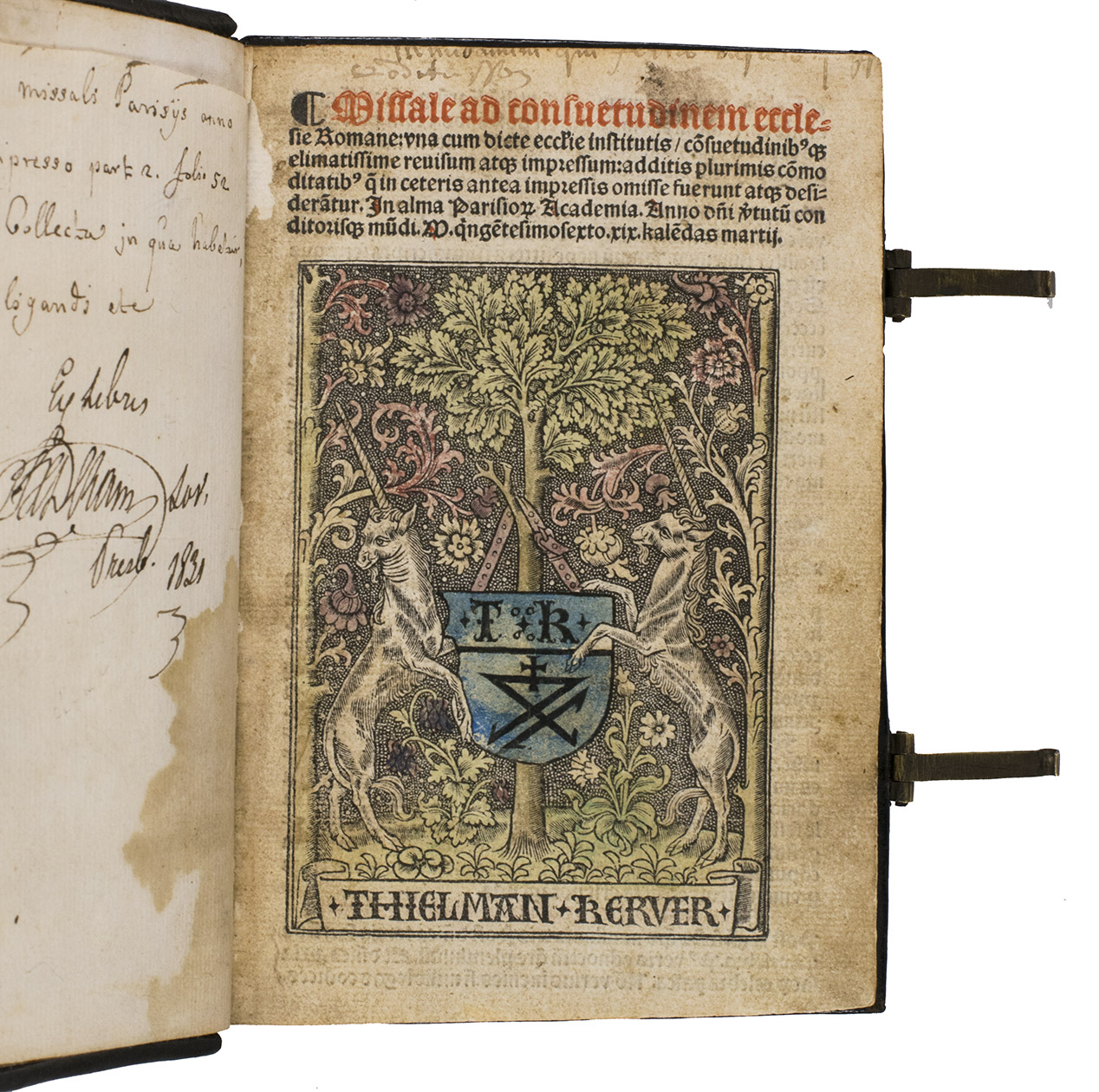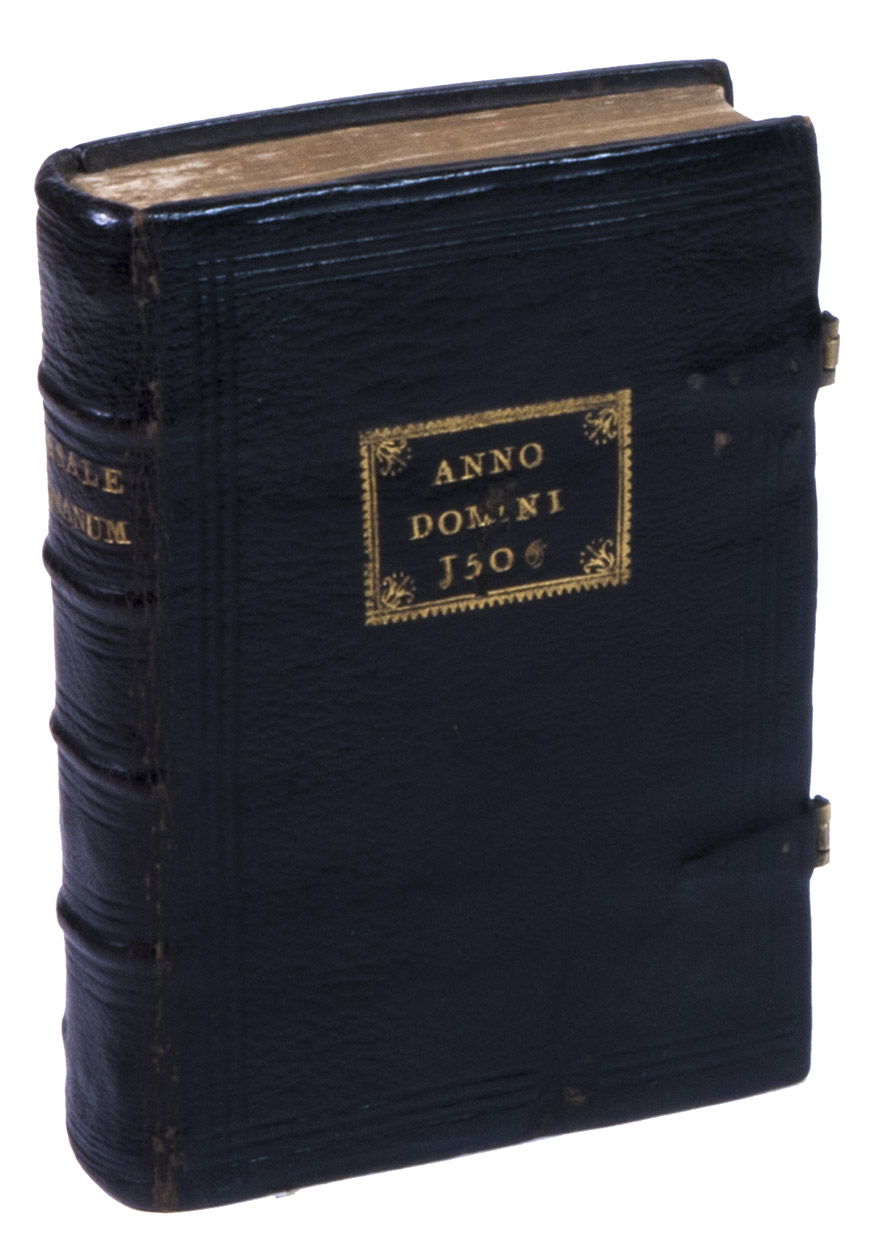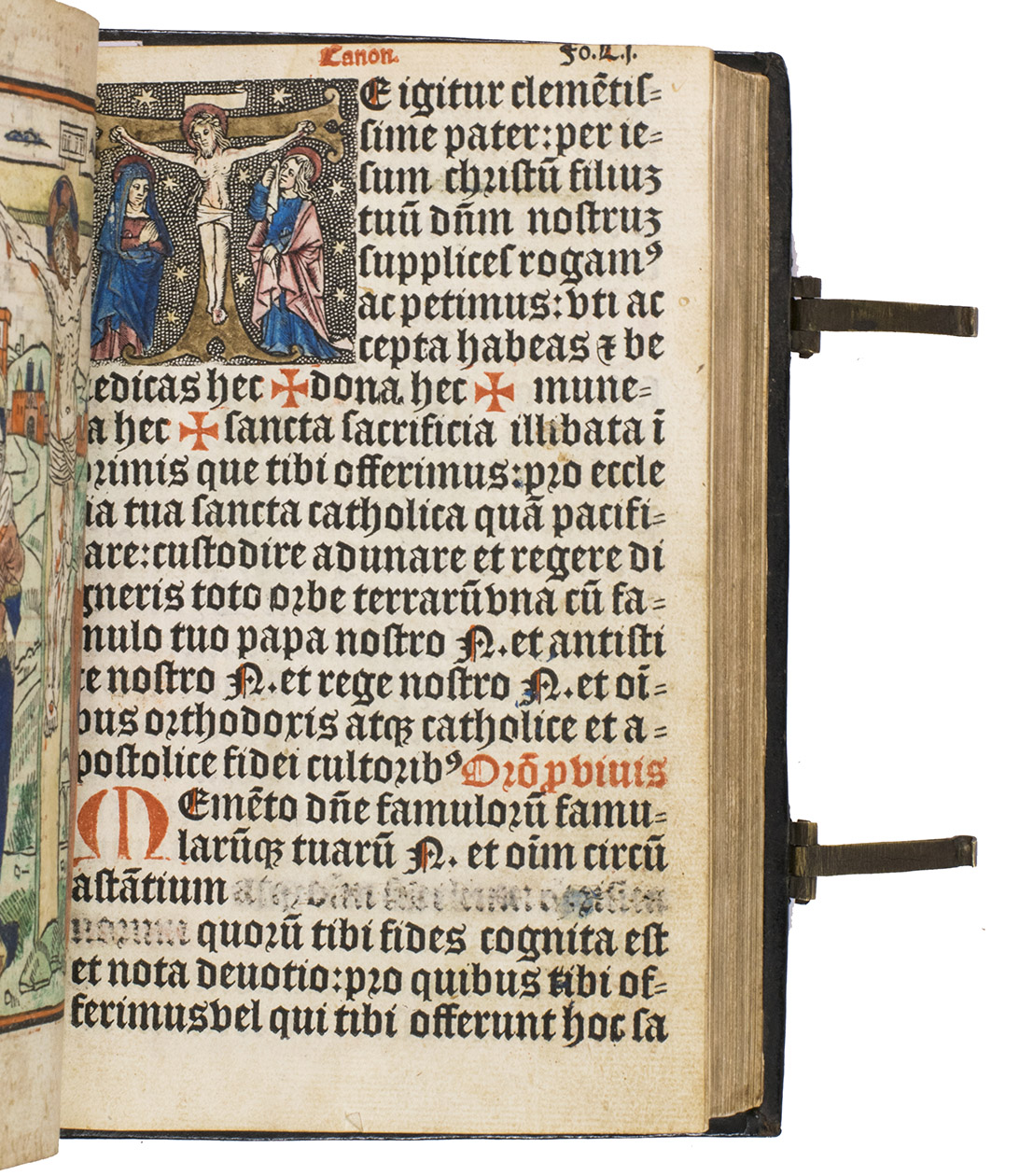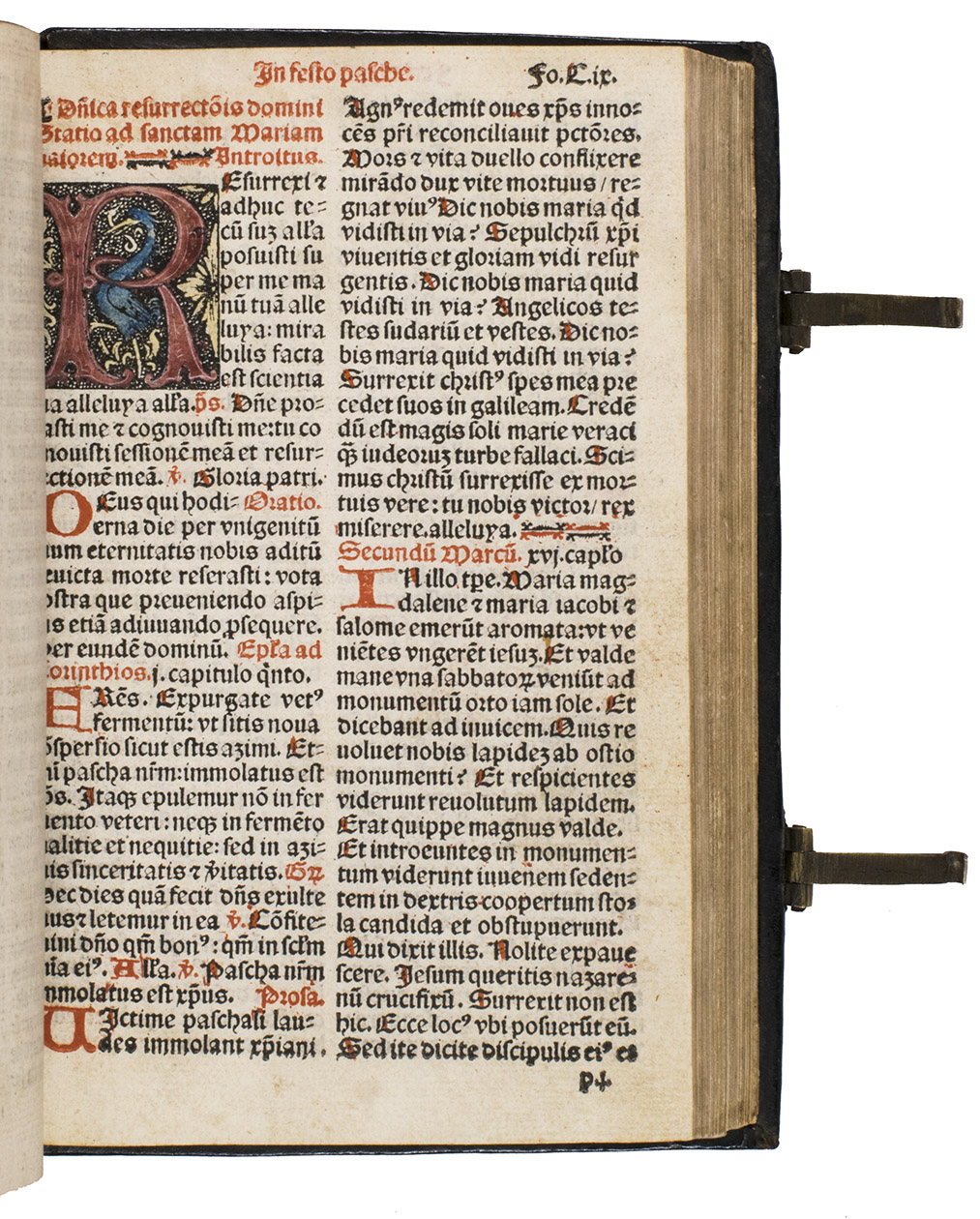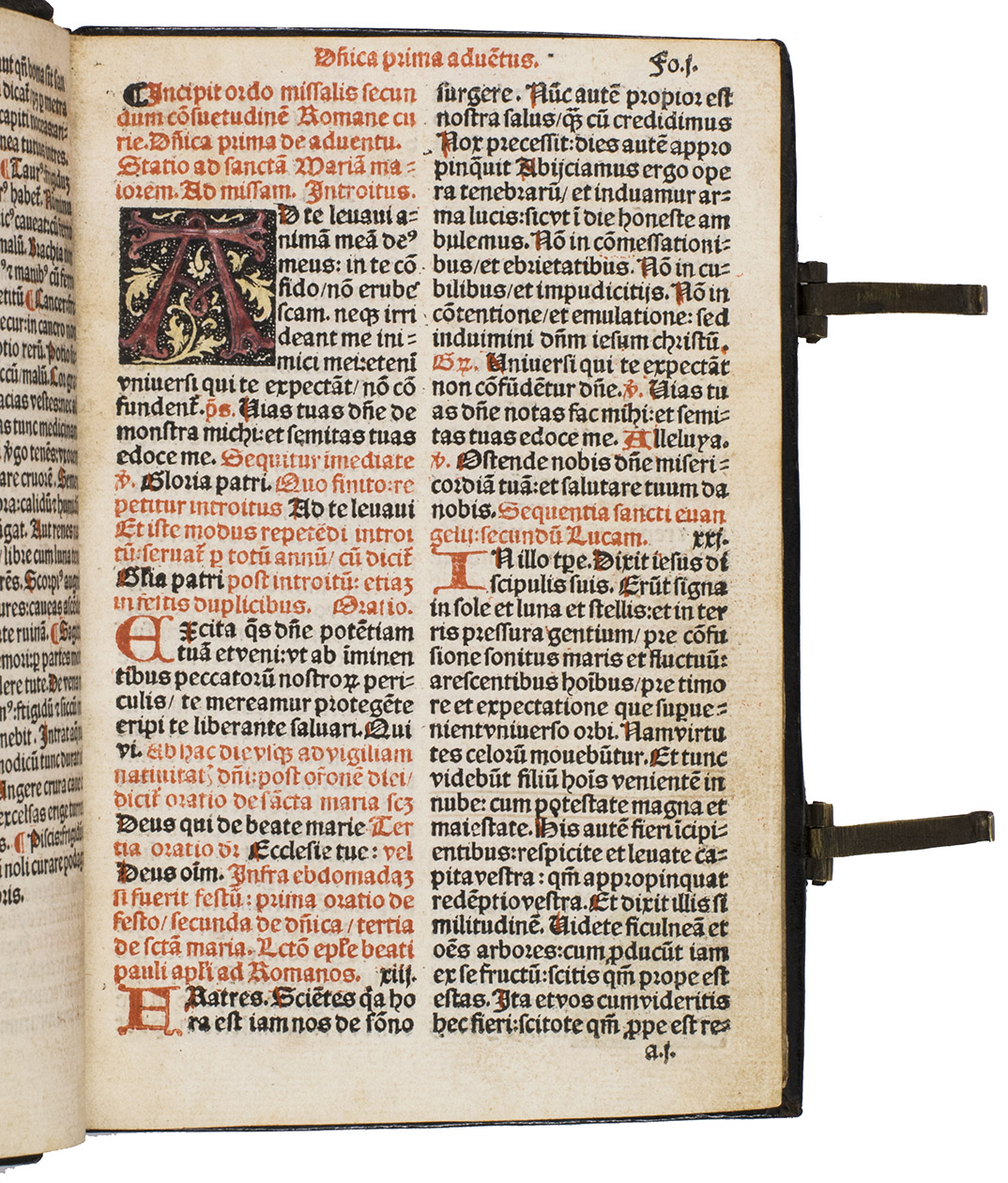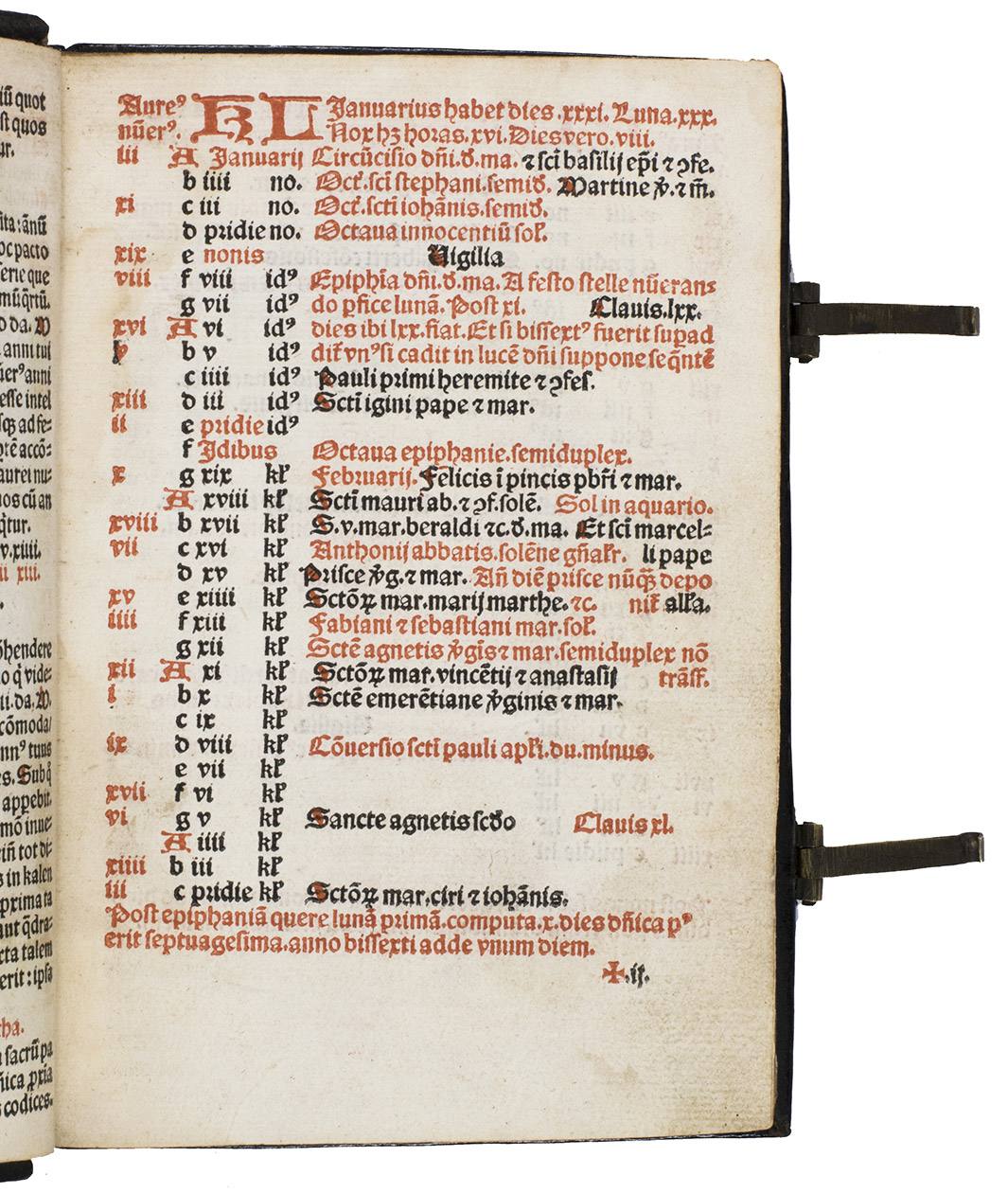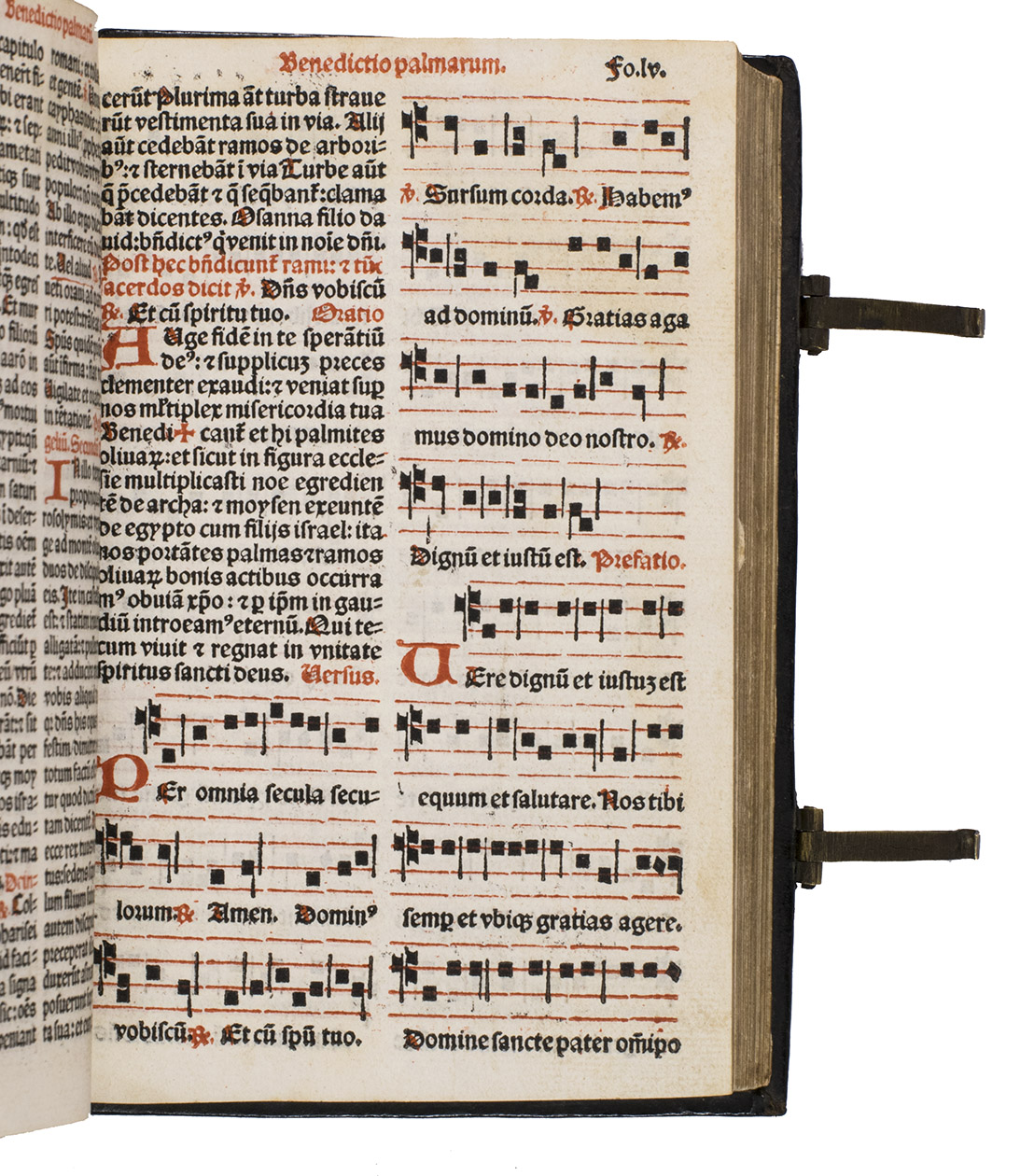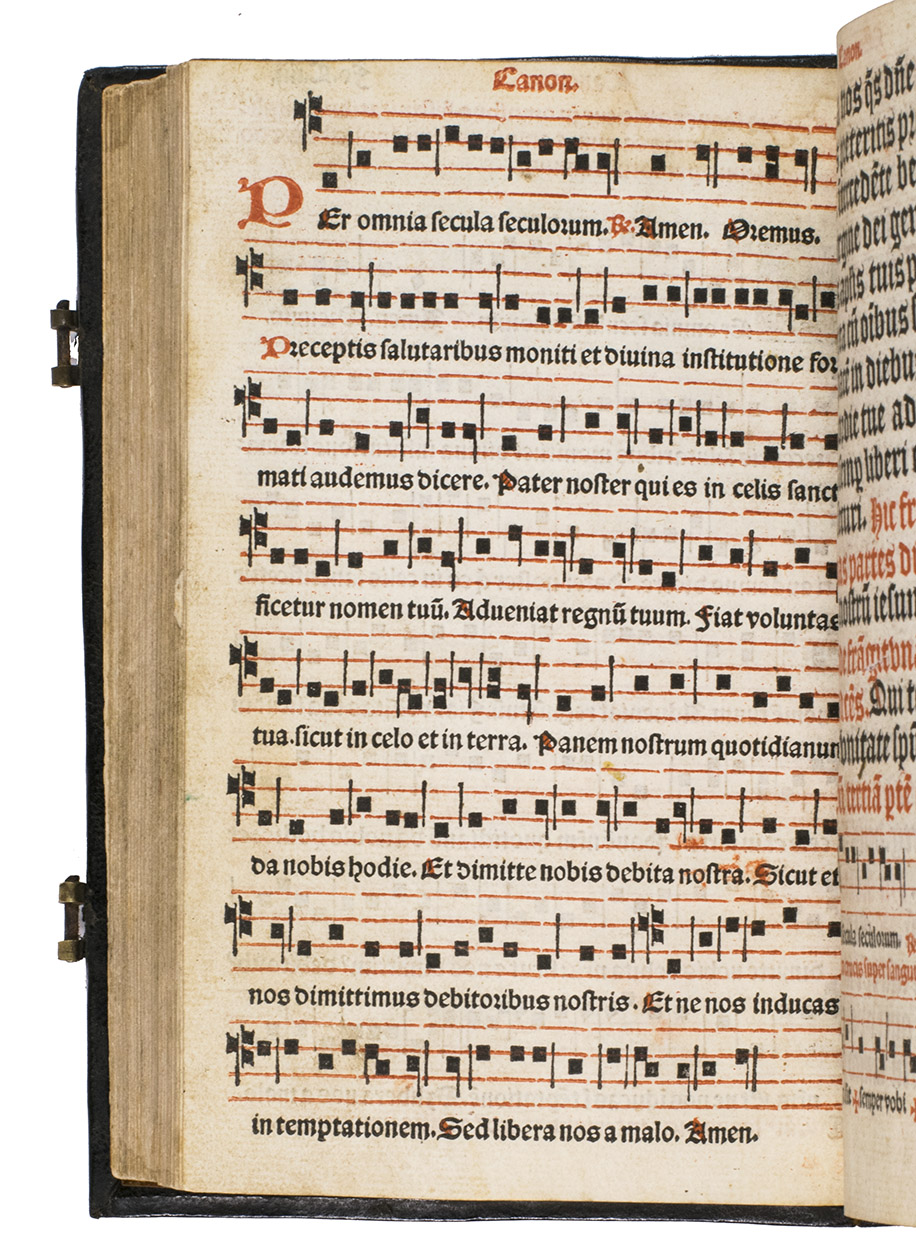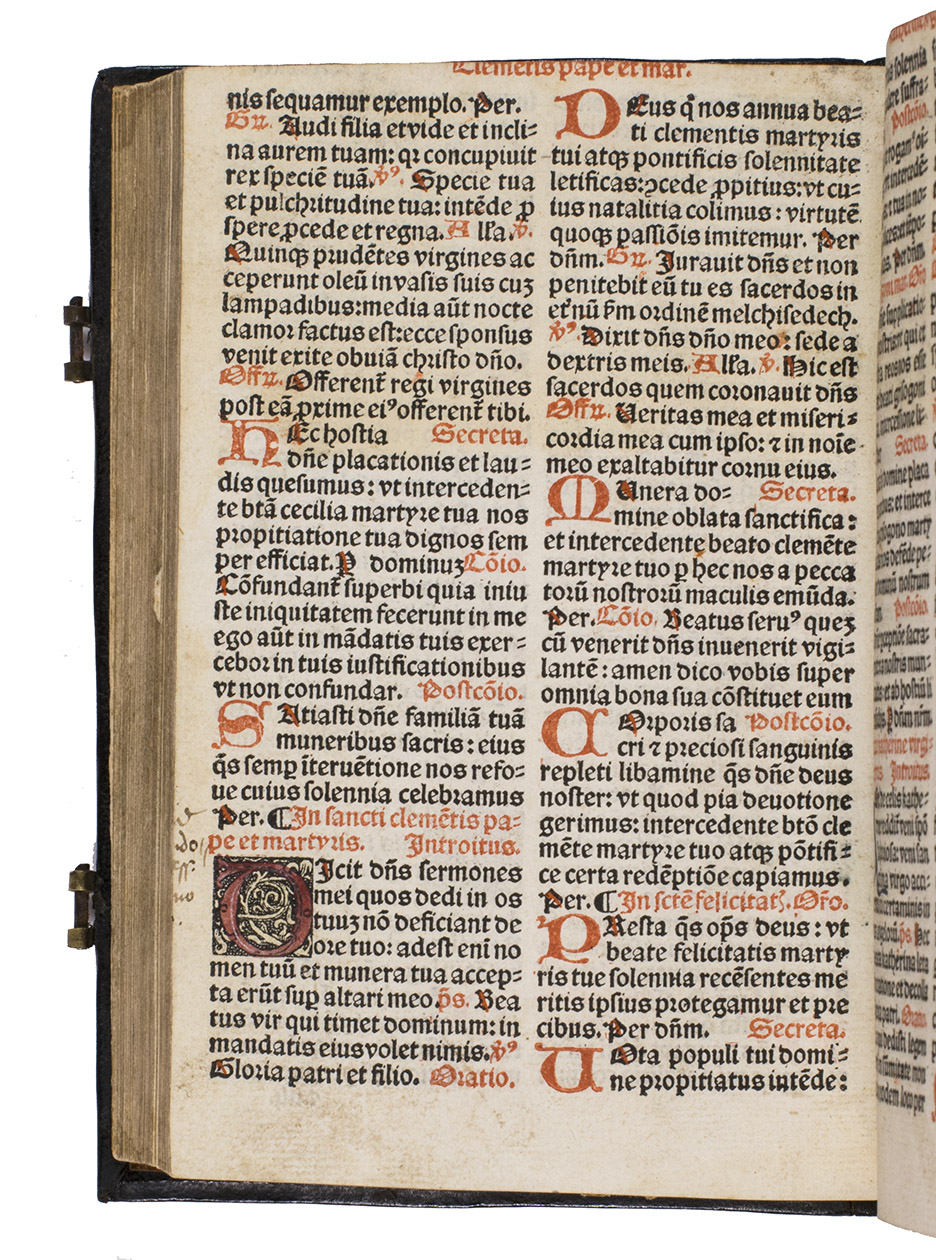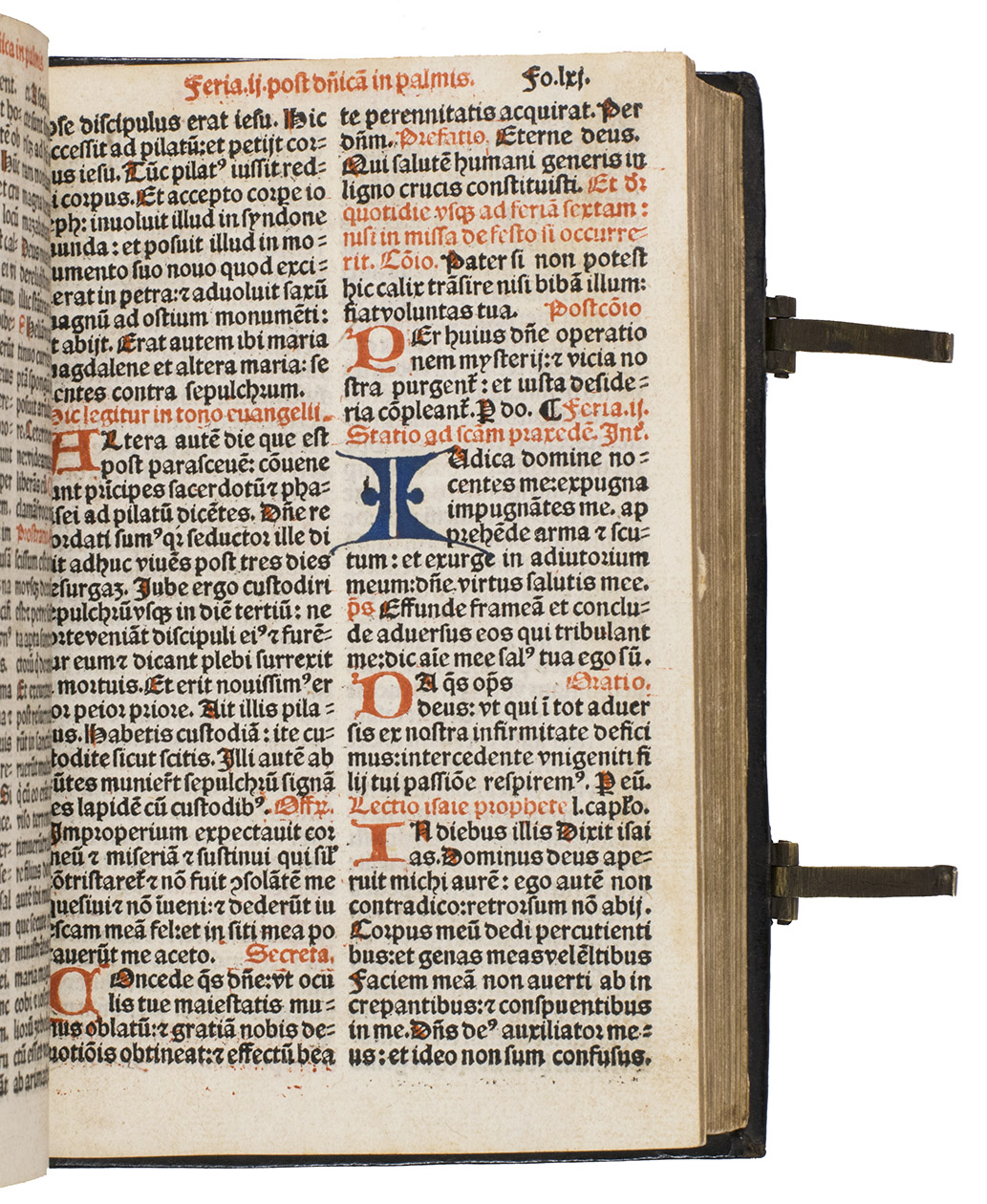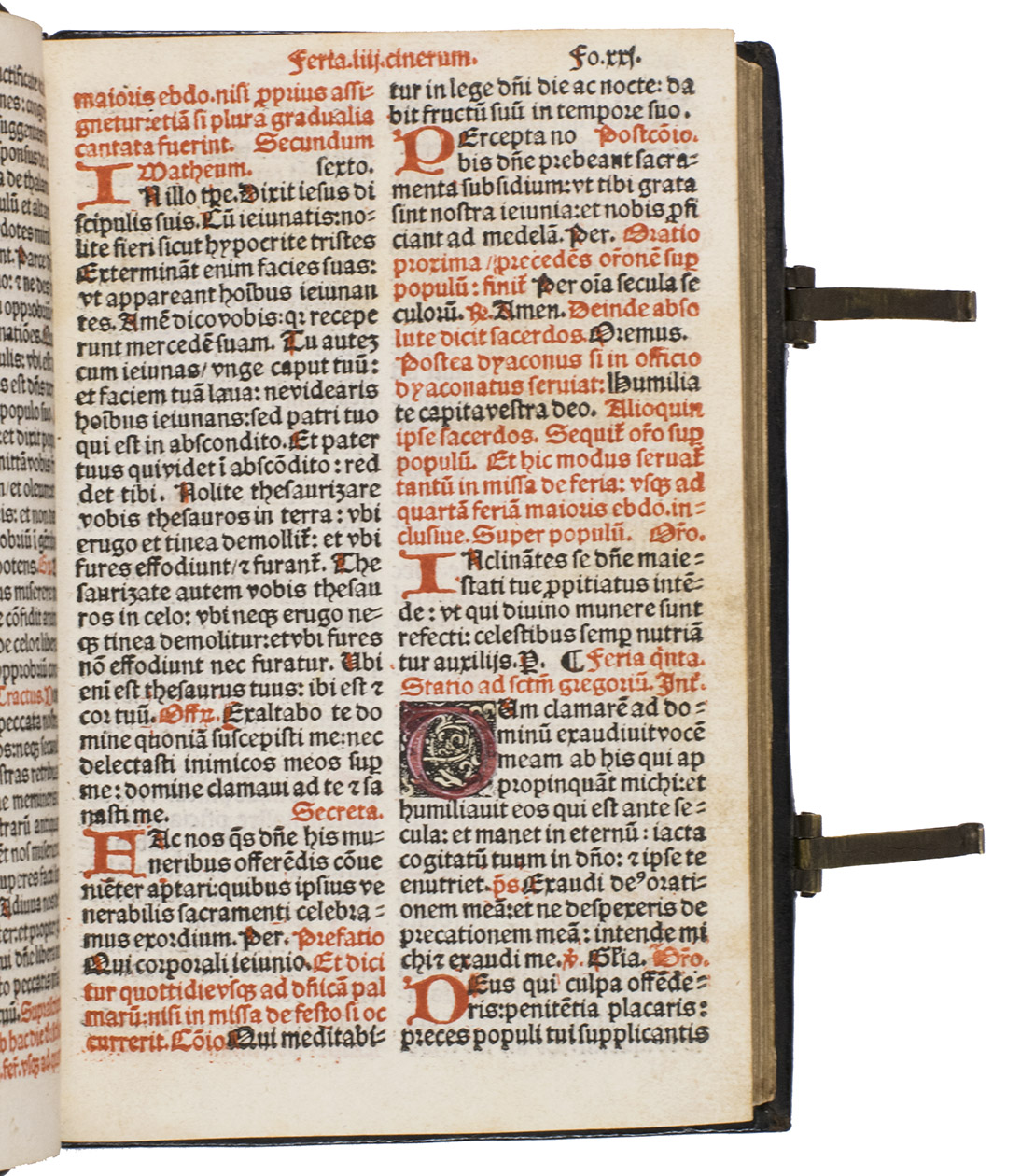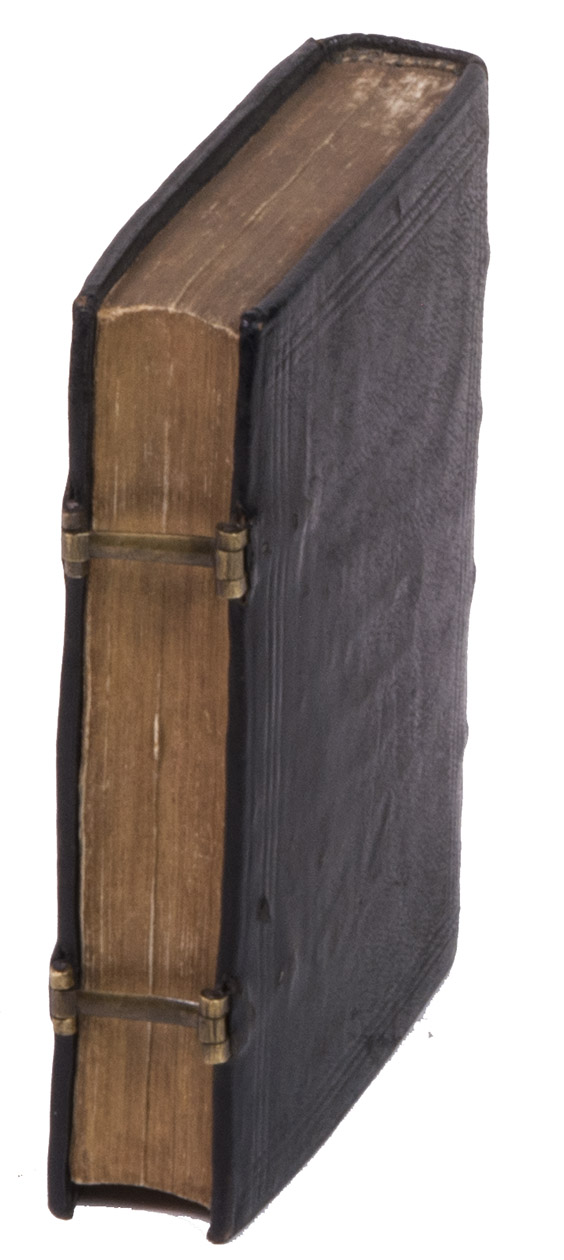[ROMAN MISSAL].
Missale ad consuetudinem Ecclesie Romane; ...
[Paris], Thielman Kerver, [colophon: anno domini 1506. x. kalendas apriles = 23 March 1507]. 8vo. Printed in red and black throughout in 2 columns, with Kervers finely executed criblée armorial device on the title page, a crucifixion woodcut, hundreds of impressions of at least 28 finely executed lombardic initials with decorations, as well as dozens of spaces left for manuscript initials, about half with printed guide letters, and a two-impression plainchant music type. The capitals are rubricated throughout. The main text is set in a rotunda gothic type, and the Canon in a larger textura gothic. The woodcut crucifixion, Kervers device and the criblée initials are all coloured by a contemporary hand. Gold- and blind-tooled black goatskin morocco (1st half of the 18th century), the front board dated "ANNO|DOMINI|1506" in gold, and the spine-title "MISSALE|ROMANUM" in gold, marbled endpapers, gilt edges, 2 brass fastenings. [8], 233, [3] ll.
€ 15,000
The rare first missal for the Roman rite to be printed or published by the great Paris printing and publishing family Kerver, best known for their luxurious liturgical and devotional printing, especially their books of hours. There appears to be no copy in any French library. Kervers first missal, in 1501, was made for the Paris rite. Kervers early missals, including the present one, are extremely rare, the USTC recording no more than five copies of any edition printed before 1520.
Caerr, p. 73, notes that Kervers present first publishers device is "universally recognised as a master-piece". It has been suggested that Kervers criblée blocks were metal cuts rather than woodcuts. The crucifixion scene facing the opening of the Canon is a more traditional woodcut. Caerr, p. 51, suggests Kerver reached the pinnacle of his success in his stylistic evolution in or around 1506, fully incorporating Renaissance tastes in the period 1505-1514 and perfecting the criblée technique used for his present publishers device and initials. The present edition is also a very early example of the use of abstract typographic ornaments. The preliminaries include a calendar of feast days and most of its less common Saints days printed in red suggest a Franciscan connection.
Thielman Kerver (Koblenz? ca. 1460/70?-Paris 1522) appears in Paris imprints as a bookseller and publisher working with various printers and co-publishers from 1497, beginning with books of hours, which always remained his greatest speciality. He added his own printing office in 1498, though he continued to work with others, and expanded into a wide variety of genres. He also added other kinds of liturgical books, including breviaries from 1499, a psalter in 1500/01 and missals from 1501, apparently publishing about 16 missals to his death in 1522, first using the present form of the title in the present edition. He was sworn in as official bookseller to the University in Paris in 1501 and soon after also printer, hence the "In alma Parisiorum Academia" in the present title and colophon. Kervers widow continued the firm from 1522 to her death in 1557, their son Jacques continued it to his death in 1583 and its materials were sold in 1586.
The fact that both the wording of the title and the exact date differ between the title page and the colophon (the latter is 40 days later) has led nearly every reference work from Weale in 1886 to the present USTC to turn one 1506 edition into two, most describing a folio edition by Kerver (a ghost) and an anonymous 8vo edition (supposedly with no copy known). David Shaw provided an accurate description on-line, based on the British Library copy.
With an inscription in the head margin of the title page, partly shaved and difficult to read; the engraved publishers device of the Antwerp printer and publisher Jean Baptiste III Verdussen (1698-1773) on the front and back pastedown, serving as his bookplate (see above). Also with an 1831 owners inscription of S.[?] De Ram on a free endleaf facing the title page. The rubricator or an early owner has added several notes in red in the calendar. Further with an occasional early marginal manuscript note, some shaved. Four words in the Canon have been deliberately erased as an editorial revision. With an 8 cm tear into one leaf , the running heads of a few others shaved, the title-page slightly soiled, a 3 mm hole in leaf 232 (E4) affecting 2 or 3 words, some tiny marginal wormholes in a few leaves and some water stains in the endpapers, otherwise in very good condition. The binding shows a few small defects, one slightly affecting the gold lettering on the front board, but is also generally very good. A rare and beautifully produced missal, and the second major display of Kervers stunning criblée initials, all coloured by a contemporary hand, as are the woodcut and Kerver's device. Thierry Caerr, Imprimerie et réussite sociale à Paris ...: Thielman Kerver ..., 2000, 2 vols. (www.enssib.fr/bibliotheque-numerique), 117 (4 copies, erroneously described as a folio); Catalogue ... bibliothèque de feu ... Jean de Meyer (Ghent, 2-5 November 1869), lot 33 (8vo, 23 March 1506, not mentioning Kerver, but with "alma Parisiorum Academia"); Pettegree, French books 68270 (not noting Kervers name) & 68271 (erroneously described as a folio) (1 of the same 4 copies); Frank Isaac reworked by David Shaw, frenchpostincunables.djshaw.co.uk, IS000343; USTC 68270 (not noting Kervers name) & 180236 (erroneously described as a folio) (same copy as Pettegree); Catalogue ... de la bibliothèque de M. Jean François van de Velde (Ghent, 1831), lot 1360 (with an extra woodcut inserted facing leaf 58); Catalogus librorum Joannis Baptistae Verdussen (Antwerp, widow of Hieronymous Verdussen, 15 July 1776), liturgy lot 45 (the present copy); Weale & Bohatta, Bibliographia liturgica (1928), 982 (23 March 1506, 2 copies) & 985 ([11] February 1506, not noting Kervers name, no copy located), both on p. 147 in the 1886 ed.; WorldCat 152428895, 315474570, 843131050, 843131052, 906577964, 1063178422 (5 copies plus 2 ghosts); not in Adams (no Kerver missal before 1515); Davis, Fairfax Murray (French), (no Kerver missal); Mortimer, Harvard (French), (no Kerver missal before 1574); SUDOC; catalogue.bnf.fr.
Related Subjects:
